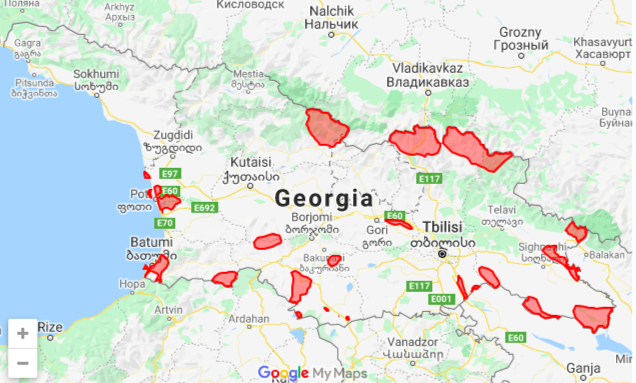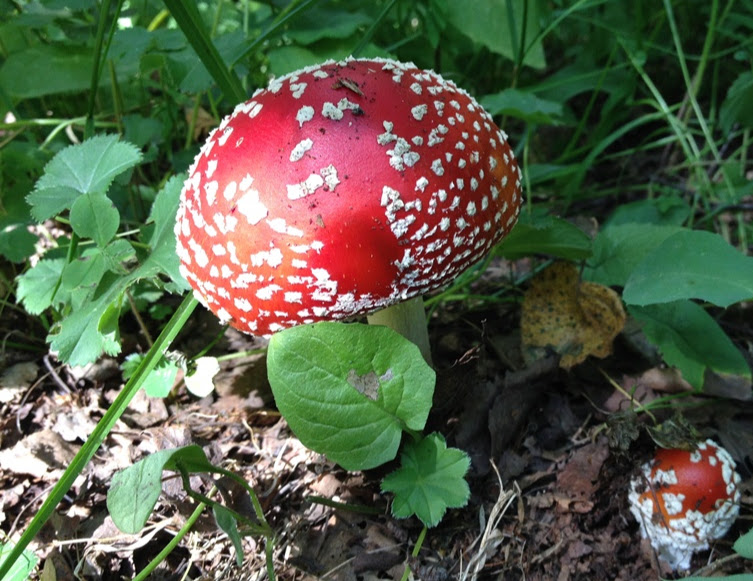Taxonomy
Kingdom Animalia (16266)Phylum Chordata (708)
Class Mammalia (111)
Order Carnivora (18)
Family Mustelidae (8)
Genus Lutra (1)
Species Lutra lutra
Browse by taxonomy
Simple search by name
Lutra lutra ✓
Eurasian Otter, Common Otter, წავი
Name According To: www.redlist.org
Species: lutra
Taxon Rank: Species
Scientific Name Authorship: (Linnaeus, 1758)
Vernacular Name: Eurasian Otter, Common Otter
Georgian Name: წავი
GBD Remarks:
Conservation Status (International): IUCN status (international) NT, ver 3.1.
Conservation Status (national): Georgian Red List. IUCN National status (2006) VU (B1(bI)): (range declining because of vegetation destruction along the river banks and reduction of feeding grounds due to water pollution).
Economic importance (national): Currently absent. Some damage to fish farms.
Monitoring methods: tracking, transect survey along river banks, camera-trapping
Research activities: Vertebrate Lab of the Institute of Zoology, Ilia State University, contact person - Alexander Bukhnikashvili. NGO NACRES, contact person George Gorgadze. Monitoring of few otter habitats were executed during the follow-up monitoring of BP Baku-Ceyhan pipeline project.
Relevant website: http://www.iucnredlist.org/details/12419/0 ; http://nacres.org/lmam02.html
Specific relevant information. So far, otter is recorded at 36 Georgian locations (see the list below) located at various landscape and altitude (Bukhnikashvili et al 2007). Selection of these locations can be used for a long-term monitoring program. Most important food item in Georgia, especially in winter time, is fish, specifically - crucian carp (Carassius carassius) (Gorgadze 2013).
Why to monitor: Species rare and important for conservation. However, validated data on the population number absents for Georgia.
Preliminary suggestion: rely on the monitoring on 5-10 selected sites.
კონსერვაციული სტატუსი (საერთაშორისო): IUCN სტატუსი (საერთაშორისო) NT ver 3.1.
კონსერვაციული სტატუსი (ეროვნული): საქართველოს წითელი ნუსხა. IUCN ეროვნული სტატუსი (2006) VU (B1(bI)): (არეალის შემცირება მდინარეების სანაპირო ეკოსისტემის დეგრადაციის შედეგად და საკვები ბაზის შემცირება მდინარეების დაბინძურების გამო).
ეკონომიკური მნიშვნელობა (ეროვნული): უმნიშვნელოა. გარკვეული ზარალი მოაქვს თევზსაშენი მეურნეობებისთვის.
მონიტორინგის მეთოდები: კვალზე დადევნება, ტრანსექტული აღრიცხვები მდინარის პირის გასწვრივ, ცნობილი ლოკალიტეტების მონიტორინგი ფოტოხაფანგების მეშვეობით.
კვლევები: ილიას სახელმწიფო უნივერსიტეტის ეკოლოგიის ინსტიტუტი, ზოოლოგიის ინსტიტუტი. არასამთავრობო ორგანიზაცია ნაკრესი. საკონტაქტო პირი - ალექსანდრე ბუხნიკაშვილი (ილიას უნივერსიტეტი), გიორგი გორგაძე (ნაკრესი). რამოდენიმე ლოკალიტეტის მონიტორინგი მიმდინარეობდა 2004- 2008-ში ბპ ბაქო-ჯეიხანის პროექტის დაკვეთით.
ვებსაიტი: http://www.iucnredlist.org/details/12419/0 ; http://nacres.org/lmam02.html
სპეციფიკური ინფორმაცია. წავი საქართველოში ცნობილია 36 ადგილიდან, რომლებიც განლაგებულია განსხვავებულ სიმაღლეზე და განსხვავებულ ლანდშაფტში (Bukhnikashvili et al 2007). ამ ლოკალიტეტებიდან ადვილია შეირჩეს რეპრეზენტატიული სინჯი გრძელვადიანი მონიტორინგისთვის. საკვებ ბაზას წარმოადგენს თევზი (განსაკუთრებით ზამთარში), ყველაზე მნიშვნელოვანია კარჩხანა (Carassius carassius) (Gorgadze 2013).
მონიტორინგის საჭიროება: ეროვნული პოპულაცია მოწყვლადია ჰაბიტატების დესტრუქციის გამო. საბაზო ინფორმაცია მწირია.
რეკომენდაცია: 5-10 შერჩეული ლოკალიტეტის ყოველწლიური მონიტორინგი.
Page Authors: Kandaurov A. ,
Reference of occurrence in Georgia: Bukhnikashvili, A. & Kandaurov, A., 2002. The annotated list of mammals of Georgia. Proceedings of the Institute of Zoology, Tbilisi, XXI: 319-336
Georgian biodiversity database contains 36 occurrences of Lutra lutra
| Occurrence ID | Basis of Record | Locality | Recorded By | Decimal Latitude | Decimal Longitude |
| 6606 | Ritsa | 43.48382777950 | 40.61042286080 | ||
| 6607 | Inkiti | 43.18923582770 | 40.33967072020 | ||
| 6608 | Kelasuri | 42.79587894420 | 41.28474894700 | ||
| 6609 | Bebesiri | 42.65965145200 | 41.57763805510 | ||
| 6610 | Okumi | 42.63070310990 | 41.60318070990 | ||
| 6612 | Tikori | 42.40933343520 | 41.63212905190 | ||
| 6613 | Kharkalu | 42.25267181920 | 41.78879066790 | ||
| 6614 | Churia | 42.19988366600 | 41.70535132900 | ||
| 6615 | Tsivi | 42.11474148340 | 41.75984232580 | ||
| 6616 | Poti | 42.09430735960 | 42.11062811810 | ||
| 6617 | Maltakva | 42.05684479930 | 42.67426936690 | ||
| 6618 | Nigvziani | 41.62261966810 | 42.80879401540 | ||
| 6619 | Patara Narionali | 41.65156801010 | 42.91947885270 | ||
| 6620 | Vale Parekha | 41.70776185060 | 43.14084852750 | ||
| 6621 | Minadze | 41.62602535540 | 43.14084852750 | ||
| 6622 | Tsnisi | 41.72308744350 | 43.67213574680 | ||
| 6623 | Narianis Veli | 41.64305379190 | 43.66702721590 | ||
| 6624 | Tabatskuri | 41.23777700270 | 43.23791061560 | ||
| 6625 | Kartsakhi | 41.37230165120 | 43.77090067860 | ||
| 6626 | Gandzani | 41.30248506150 | 43.72662674370 | ||
| 6627 | Sagamo | 41.17136610030 | 43.76408930400 | ||
| 6628 | Madatapa | 41.69413910140 | 44.83858364840 | ||
| 6629 | Tbilisi | 41.72479028720 | 45.18426090970 | ||
| 6630 | Korugi | 42.04492489370 | 45.28643152880 | ||
| 6631 | Laliskuri | 42.01767939530 | 45.46352726860 | ||
| 6632 | Napareuli | 41.76906422210 | 45.91818652360 | ||
| 6633 | Kure | 41.70946469430 | 45.99992301890 | ||
| 6634 | Kabali | 41.60899691880 | 46.28429790880 | ||
| 6635 | Matsimis Kure | 41.49831208150 | 46.34049174930 | ||
| 6636 | Alazani Sanctuary | 41.41487274250 | 46.51077611450 | ||
| 6637 | Milari | 41.33654193450 | 46.67595194870 | ||
| 6638 | Sabatlo | 41.44382108460 | 45.67127419410 | ||
| 6639 | Kolagiri-Kvabebi | 41.32973055990 | 45.85007277750 | ||
| 6640 | Iori-Kurbaba | 41.23096562810 | 45.94372917840 | ||
| 6641 | Dali Reservoir | 41.20542297340 | 46.07484813960 | ||
| 6642 | Chachuna | 41.18498884950 | 46.21618416270 |
Information from GBIF about Lutra lutra
GBIF scientific name: Lutra lutra (Linnaeus, 1758)
GBIF taxonomic status: ACCEPTED

Conservation Status
This section is under construction
National Red List Status: LC
IUCN Red List Status: NT
Protection status: Not defined
Reason: N/A
Trend: Stable
EOO: >20000
AOO: >2000
Native/Introduced: Native
Comment: **
Georgian Name: წავი
English Name: Eurasian Otter, Common Otter
SubSpecies: Lutra lutra meridionalis
Taxonomy according to: www.redlist.org
References: Bukhnikashvili, A. & Kandaurov, A., 2002. The annotated list of mammals of Georgia. Proceedings of the Institute of Zoology, Tbilisi, XXI: 319-424
Evaluated By: Bukhnikashvili A., Kandaurov A., Natradze I.
Date evaluated: Nov 2021


